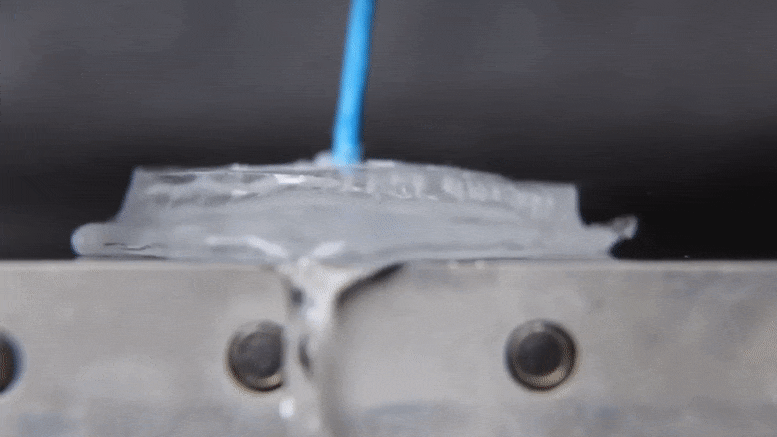
A study led by Jonathan Boreyko has uncovered that ice can levitate at high temperatures, potentially revolutionizing industrial cooling processes and firefighting techniques by enhancing heat transfer efficiency. Credit: Virginia Tech
New research reveals that ice can levitate under extreme temperatures, using a phenomenon known as the Leidenfrost effect. This finding has significant implications for improving heat transfer in industrial cooling systems and emergency firefighting technologies.
Associate Professor Jonathan Boreyko and graduate fellow Mojtaba Edalatpour have made a discovery about the properties of water that could provide an exciting addendum to a phenomenon established over two centuries ago. The discovery also holds interesting possibilities for cooling devices and processes in industrial applications using only the basic properties of water. Their work was published today (January 21, 2022) in the journal Physical Review Fluids.
Water can exist in three phases: a frozen solid, a liquid, and a gas. When heat is applied to a frozen solid, it becomes a liquid. When applied to the liquid, it becomes vapor. This elementary principle is familiar to anyone who has observed a glass of iced tea on a hot day, or boiled a pot of water to make spaghetti.
Exploring the Leidenfrost Effect
When the heat source is hot enough, the water’s behavior changes dramatically. According to Boreyko, a water droplet deposited onto an aluminum plate heated to 150 degrees Celsius (302 degrees Fahrenheit) or above will no longer boil. Instead, the vapor that forms when the droplet approaches the surface will become trapped beneath the droplet, creating a cushion that prevents the liquid from making direct contact with the surface. The trapped vapor causes the liquid to levitate, sliding around the heated surface like an air hockey puck. This phenomenon is known as the Leidenfrost effect, named for the German doctor and theologian who first described it in a 1751 publication.
This commonly accepted scientific principle applies to water as a liquid, floating on a bed of vapor. Boreyko’s team found themselves wondering: Could ice perform in the same way?
“There are so many papers out there about levitating liquid, we wanted to ask the question about levitating ice,” said Boreyko. “It started as a curiosity project. What drove our research was the question of whether or not it was possible to have a three-phase Leidenfrost effect with solid, liquid, and vapor.”
Watch video of ice levitating.
The Challenge of Levitating Ice
Curiosity sparked the first investigation in Boreyko’s lab some five years ago in the form of a research project by then-undergraduate student Daniel Cusumano. What he observed was fascinating. Even when the aluminum was heated above 150 C, the ice did not levitate on vapor as liquid does. Cusumano continued raising the temperature, observing the behavior of the ice as the heat increased. What he found was that the threshold for levitation was dramatically higher: 550 C (1022 F) rather than 150 C. Up until that threshold, the meltwater beneath the ice continued to boil in direct contact with the surface, rather than exhibit the Leidenfrost effect.
What was going on underneath the ice that prolonged the boiling? The project was picked back up by graduate student Mojtaba Edalatpour a short time later, to solve the mystery. Edalatpour had been working with Boreyko to develop novel methods of heat transfer and put that knowledge to work in approaching this problem. The answer turned out to be the temperature differential in the meltwater layer beneath the ice. The meltwater layer has two different extremes: Its bottom is boiling, which fixes the temperature at about 100 C (212 F), but its top is adhered to the remaining ice, which fixes it at about 0 C (32 F). Edalatpour’s model revealed that the maintenance of this extreme temperature differential consumes most of the surface’s heat, explaining why levitation was more difficult for ice.
Boreyko elaborated. “The temperature differential the ice is uniquely creating across the water layer has changed what happens in the water itself, because now most of the heat from the hot plate has to go across the water to maintain that extreme differential. So only a tiny fraction of the energy can be used to produce vapor anymore.”
Practical Applications and Future Prospects
The elevated temperature of 550 degrees Celsius for the icy Leidenfrost effect is practically important. Boiling water is optimally transporting heat away from the substrate, which is why you feel ample heat rising from a pot of water that is boiling, but not from a pot of water that is merely hot. This means that the difficulty in levitating ice is actually a good thing, as the larger temperature window for boiling will result in better heat transfer compared to using a liquid alone.
“It is much harder to levitate the ice than it was to levitate the water droplet,” said Boreyko. “Heat transfer plummets as soon as levitation begins, because when liquid levitates, it doesn’t boil anymore. It’s floating over the surface rather than touching, and touching is what causes it to boil the heat away. So, for heat transfer, levitation is terrible. Boiling is incredible.”
Using Ice for Heat Transfer
As the team explored possibilities for practical application, they looked to their existing work. Since Edalatpour had extensive research in heat transfer, that topic became a logical fit.
Heat transfer comes most into play for cooling off things like computer servers or car engines. It requires a substance or mechanism that can move energy away from a hot surface, redistributing heat quickly to reduce the wear and tear on metal parts. In nuclear power plants, the application of ice to induce rapid cooling could become an easily-deployed emergency measure if power fails, or a regular practice for servicing power plant parts.
There are also potential applications for metallurgy. To produce alloys, it is necessary to quench the heat from metals that have been shaped in a narrow window of time, making the metal stronger and less brittle. If ice were applied, it would allow heat to be offloaded rapidly through the three water phases, quickly cooling the metal.
Boreyko also foresees a potential for applications in firefighting.
“You could imagine having a specially made hose that is spraying ice chips as opposed to a jet of water,” he said. “This is not science fiction. I visited an aerospace company that has an icing tunnel and they already have this technology where a nozzle sprays out ice particles as opposed to water droplets.”
With myriad possibilities, Boreyko and Edalatpour are excited about the new contribution that has come to the science world. Looking back over the past five years, they still credit this exciting development to their shared spark of curiosity and the drive to be creative in research.
Reference: “Three-phase Leidenfrost effect” by Mojtaba Edalatpour, Daniel T. Cusumano, Saurabh Nath and Jonathan B. Boreyko, 21 January 2022, Physical Review Fluids.
DOI: 10.1103/PhysRevFluids.7.014004









In 2003 The Institute for Venture Science in Seattle, led by Prof. Gerald Harvey Pollack of the School of Medicine, University of Washington, identified the fourth phase of water, constituted by the interfacial “Exclusion Zone”, EZ, next to submersed/bordering hygroscopic materials. EZ water receives and processes the environmental EM (U.V., visible, especially I.R.) radiation, retaining and storing energy. In addition, atomic structure of ice closely resembles atomic structure of EZ water. This similarity is beyond coincidence: one transforms readily into the other.
Could EZ water play a role in the intriguing phenomenon observed by Boreyko and Edalatpour?
Babu G. Ranganathan*
(B.A. Bible/Biology)
JUST BECAUSE SCIENCE CAN EXPLAIN how an airplane works doesn’t mean that no one designed or made the airplane. And just because science can explain how life or the universe works doesn’t mean there was no Designer and Maker behind them.
Natural laws may explain how the order in the universe works and operates, but mere undirected natural laws cannot explain the origin of that order. Once you have a complete and living cell then the genetic code and biological machinery exist to direct the formation of more cells from raw materials such as amino acids and other chemicals, but how could life or the cell have naturally originated when no directing code and mechanisms existed in nature? Read my Internet article: HOW FORENSIC SCIENCE REFUTES ATHEISM.
WHAT IS SCIENCE? Science simply is knowledge based on observation. No human observed the universe coming by chance or by design, by creation or by evolution. These are positions of faith. The issue is which faith the scientific evidence best supports.
SCIENCE SHOWS THAT THE UNIVERSE CANNOT BE ETERNAL because it could not have sustained itself eternally due to the law of entropy (increasing and irreversible net energy decay, even in an open system). Even a hypothetical oscillating universe could not continue to oscillate eternally! Einstein’s General Theory of Relativity shows that space, matter, and time all are physical and all had a beginning. Space even produces particles because it’s actually something, not nothing. What about the Higgs boson (the so-called “God Particle”)? The Higgs boson, even if it existed, would not have created mass from nothing, but rather it would have converted energy into mass. Einstein showed that all matter is some form of energy. Even time had a beginning! Time is not eternal.
The law of entropy doesn’t allow the universe to be eternal. If the universe were eternal, everything, including time and space (which modern science has shown are as physical as mass or matter), would have become totally entropied by now and the entire universe would have ended in a uniform heat death a long, long time ago. The fact that this hasn’t happened already is powerful evidence for a beginning to the universe.
Popular atheistic scientist Stephen Hawking admits that the universe had a beginning and came from nothing but he believes that nothing became something by a natural process yet to be discovered. That’s not rational thinking at all, and it also would be making the effect greater than its cause to say that nothing created something. The beginning had to be of supernatural origin because science teaches us from the First Law of Thermodynamics that natural laws and processes do not have the ability to bring something into existence from nothing.
The supernatural origin of the universe cannot be proved by science but science points to a supernatural intelligence and power for the origin and order of the universe. Where did God come from? Obviously, unlike the universe, God’s nature doesn’t require a beginning.
The disorder in the universe can be explained because of chance and random processes, but the order can be explained only because of intelligence and design.
Gravity may explain how the order found in the precise and orderly courses of thousands of billions of stars is maintained, but gravity cannot explain the origin of that order.
Some evolutionary astronomers believe that trillions of stars crashed into each other leaving surviving stars to find precise orderly orbits in space. Not only is this irrational, but if there was such a mass collision of stars then there would be a super mass residue of gas clouds in space to support this hypothesis. The present level of residue of gas clouds in space doesn’t support the magnitude of star deaths required for such a hypothesis. And, as already stated, the origin of stars cannot be explained by the Big Bang because of the reasons mentioned above. It’s one thing to say that stars may decay and die into random gas clouds, but it is totally different to say that gas clouds form into stars.
Even the father of Chaos theory admitted that the “mechanisms” existing in the non-living world allow for only very rudimentary levels of order to arise spontaneously (by chance), but not the kind or level of order we find in the structures of DNA, RNA, and proteins. Yes, individual amino acids have been shown to come into existence by chance but not protein molecules which require that the various amino acids be in a precise sequence just like the letters found in a sentence.
Some things don’t need experiment or scientific proof. In law there is a dictum called prima facie evidence. It means “evidence that speaks for itself.”
An example of a true prima facie would be if you discovered an elaborate sand castle on the beach. You don’t have to experiment to know that it came by design and not by the chance forces of wind and water.
If you discovered a romantic letter or message written in the sand, you don’t have to experiment to know that it was by design and not because a stick randomly carried by wind put it there. You naturally assume that an intelligent and rational being was responsible.
It’s interesting that Carl Sagan would have acknowledged sequential radio signals in space as evidence of intelligent life sending them, but he wouldn’t acknowledge the sequential structure of molecules in DNA (the genetic code) as evidence of an intelligent Cause. Read my popular Internet article, HOW DID MY DNA MAKE ME.
I encourage all to read my popular Internet articles:
NATURAL LIMITS TO EVOLUTION
HOW FORENSIC SCIENCE REFUTES ATHEISM
Visit my latest Internet site: THE SCIENCE SUPPORTING CREATION (This site answers many arguments, both old and new, that have been used by evolutionists to support their theory)
Author of popular Internet article, TRADITIONAL DOCTRINE OF HELL EVOLVED FROM GREEK ROOTS
*I have given successful lectures (with question and answer period afterwards) defending creation before evolutionist science faculty and students at various colleges and universities. I’ve been privileged to be recognized in the 24th edition of Marquis “Who’s Who in The East” for my writings on religion and science.
Absolute quack. Your articles show a complete lack of understanding (or willful misrepresentation) of geology, evolution, physics, and science in general. Not only that, but you don’t offer a single piece of evidence that out of the countless religions with creation myths, yours is the “real” one
mind blowing.
ice cools more than water…
it takes more heat to generate a steam cushion form ice than from water…
“Even when the aluminum was heated above 150 C, the ice did not levitate on vapor as liquid does.”
Having read this, the answer was pretty obvious: the ice absorbed so much heat from water that vapor could not be generated.
Without vapor levitation was not possible.